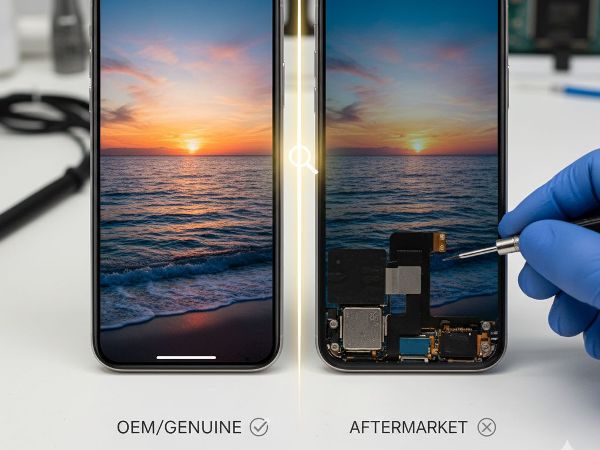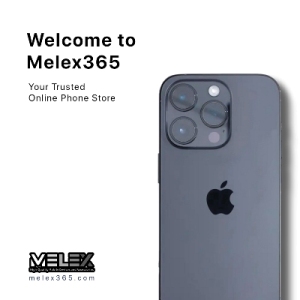Your iPhone took a tumble. That spiderweb crack across the screen is more than an aesthetic headache—it’s a critical decision point. You need a replacement, but the quotes you’re getting are wildly different. Why?
The answer lies in two acronyms: OEM (Original Equipment Manufacturer) and Aftermarket.
For an iPhone owner in the US, particularly in a tech-savvy state like California, where quality and consumer rights are paramount, understanding the difference isn’t just about saving a few dollars; it’s about preserving your phone’s performance, durability, and even its advanced features like True Tone and Face ID.
You want your iPhone to feel and function exactly as it did the day you bought it, but is that possible without paying the premium Apple price?
This comprehensive guide, written by experts with first-hand Experience in mobile repair, will cut through the repair shop jargon. We’ll break down the true quality differences between OEM and Aftermarket iPhone screen replacements so you can make an informed choice that’s right for your budget and your device.
Key Takeaways at a Glance
| Feature | OEM (Original or Refurbished) | Aftermarket (Third-Party) |
| Source | Apple or a certified Apple partner’s supply chain. | Independent third-party manufacturers. |
| Quality | Highest and most consistent quality. | Varies widely from “near-OEM” to “poor/budget.” |
| Cost | Highest upfront cost. | Significantly lower, sometimes $50-$100 less. |
| Display Functions | Full support for True Tone, auto-brightness, and Face ID. | True Tone often disabled; minor compatibility issues possible. |
| Durability | Uses stronger, proprietary glass formulations. | Glass is typically softer and more prone to scratching/cracking. |
| Compatibility Risk | Extremely low. Seamless iOS updates. | Higher risk of non-genuine part warnings after iOS updates. |
Export to Sheets
What Exactly Do “OEM” and “Aftermarket” Mean in iPhone Repair?
Before diving into the quality comparison, we need to clarify what these terms mean in the real world of iPhone repair. The lines are often blurred by repair shops, so having a clear definition is key to demonstrating your Expertise when talking to a technician.
The OEM/Genuine Distinction
OEM (Original Equipment Manufacturer) Screen: In the purest sense, this means the part was made by the original manufacturer, which is Apple or one of its certified suppliers. However, in the independent repair market, “OEM” usually falls into two categories:
- Genuine Apple Part: The screen is supplied directly from Apple, typically to an Apple Store or an Apple Authorized Service Provider (AASP).
- OEM Refurbished: An original Apple screen assembly (containing the display panel and flex cables) that was removed from a broken phone. The cracked outer glass is professionally replaced by a third-party refurbisher, leaving the high-quality, original internal components intact. This is the closest thing to a “genuine” screen you can get from an independent shop.
The Aftermarket Landscape
Aftermarket Screen: These are screens completely manufactured by a third-party company not affiliated with Apple. They are designed to fit and function like an original, but they use different materials and manufacturing processes. The quality of aftermarket screens exists on a wide spectrum:
- Premium Aftermarket (Soft/Hard OLED): High-end third-party screens that aim to mimic the display quality of an OEM part, often using a “Soft OLED” or similar technology. These offer the best value for budget-conscious users who still demand quality.
- Budget Aftermarket (LCD/Incell): The cheapest option. These screens often use older or lower-cost display technology, which can result in noticeable differences in clarity, color, and function.
The Four Critical Quality Differences
When a repair shop tries to upsell you on an OEM part, they are generally emphasizing four key areas where the difference in quality is most pronounced.
- Display Quality: Color, Brightness, and True Tone
The visual experience is where the price difference hits home.
OEM Advantage:
- Color Accuracy: OEM screens are factory-calibrated to Apple’s exact specifications (P3 wide color gamut), ensuring perfect color reproduction. This is crucial if you edit photos or rely on consistent colors for work.
- Brightness & Viewing Angles: Original screens maintain high, consistent brightness, making them easy to view in direct California sunlight. They also maintain their clarity when viewed from an angle.
- True Tone & Auto-Brightness: Genuine and high-quality OEM refurbished screens fully support True Tone, which adjusts the screen’s color temperature to the ambient light. Aftermarket screens often lose this key feature, resulting in a static, less comfortable viewing experience.
Aftermarket Drawbacks:
- Color Shift: Aftermarket screens often have a noticeable “bluer” or “cooler” tint compared to the original, making whites appear less natural.
- Dimmer Display: Many budget aftermarket screens are significantly dimmer, especially when comparing peak brightness, which can make outdoor use frustrating.
- Touch Performance and Responsiveness
The digitizer—the layer that registers your touch—is a complex component where Apple maintains tight control over quality.
OEM Advantage:
- Precision: OEM touch sensitivity is instantaneous and perfectly calibrated for the iPhone’s processor. Gestures, scrolling, and even gaming are smooth and precise.
- Haptic Feedback: The subtle haptic feedback you feel when typing or using 3D/Haptic Touch relies on precise tolerances; OEM screens ensure this system works flawlessly.
Aftermarket Drawbacks:
- Input Lag: Even high-quality aftermarket screens may have a minuscule, but perceptible, lag when rapidly dragging icons or typing quickly.
- Phantom Touch: Low-quality aftermarket screens have been known to register “phantom touches” or have sections of the screen that become completely unresponsive (dead spots), leading to the need for yet another repair.
- Durability and Longevity
How well the screen withstands your next drop is a major factor, especially for active iPhone owners.
OEM Advantage:
- Proprietary Glass: Apple uses materials like Ceramic Shield (on newer models) or chemically hardened glass. These materials are highly scratch-resistant and more durable against impact.
- Thinness: OEM screens are manufactured to extremely precise, thin specifications, ensuring a seamless fit with the phone’s frame, which is crucial for maintaining water resistance (though no repair can guarantee the original water-resistant seal).
Aftermarket Drawbacks:
- Softer Glass: Aftermarket glass is generally softer, making it more prone to micro-scratches from keys, sand, or pockets.
- Thickness: Cheaper aftermarket screens can be marginally thicker (0.3mm to 0.5mm) than the original, resulting in a tiny, noticeable “lip” where the screen meets the metal frame. This small gap can compromise the dust/splash resistance and may even damage the frame over time.
- Compatibility and iOS Updates
The iPhone is not just hardware; it’s an ecosystem. The screen works in tandem with the iOS software.
OEM Advantage:
- Seamless Integration: Original parts are recognized instantly by iOS. They maintain all security features, including Face ID and Touch ID, without triggering error messages.
- Future-Proof: OEM parts are guaranteed to remain compatible with all future iOS updates.
Aftermarket Risk:
- “Unknown Part” Warnings: For newer iPhone models (iPhone 11 and later), installing a non-genuine screen will often trigger a persistent “Important Display Message” warning in the Settings app, notifying the user that the part cannot be verified. This doesn’t stop the phone from working, but it can be a constant reminder of the non-genuine replacement.
- Feature Loss: Some advanced features rely on tiny integrated circuits (ICs) that are programmed to the original logic board. If the replacement screen’s IC cannot be paired, features like True Tone may be permanently disabled.
Focus on California: The Right to Repair and Your Rights
As an iPhone owner in California, you have enhanced protections under the Right to Repair Act (SB 244), which went into effect on July 1, 2024. This law significantly impacts your screen replacement decision and highlights the importance of Trustworthiness in your chosen repair provider.
What the California Law Means for You:
- Transparency is Mandatory: The law requires third-party repair shops to clearly disclose to the customer if they are using non-genuine or used parts before performing the repair. Always ask your technician, “Will this be an OEM or Aftermarket part, and how will that affect my phone’s features?”
- Increased Part Availability: For products over $100, Apple (and other manufacturers) must now make repair documentation, parts, and tools available to independent shops and consumers for at least seven years. This is helping to increase the availability of genuine parts, reducing the need for low-quality aftermarket alternatives.
If you are considering an independent shop, ensure they operate with full transparency regarding the origin of their parts. You can verify your rights and the law’s details on the state’s official consumer affairs website (e.g., California Department of Consumer Affairs).
Which Screen Should You Choose? A Decision Matrix
The choice between OEM and Aftermarket is purely a cost-vs-quality trade-off. There is no single right answer, only the answer that is right for you.
✅ Choose OEM Refurbished or Genuine if:
- You prioritize quality above all else: You want the original color, brightness, and touch performance.
- You need high durability: You are accident-prone or plan to keep the phone for several more years.
- You plan to resell the phone: A phone with an OEM screen replacement will retain a higher resale value, especially in markets like California, where buyers are tech-savvy.
✅ Choose Premium Aftermarket if:
- You are budget-conscious: You need to save money but can’t tolerate a terrible viewing experience.
- You don’t do color-critical work: Minor color shifts won’t affect your day-to-day use.
- The phone is a backup or is only needed for a short time: You’re simply trying to extend its life for 6–12 months.
❌ Avoid Budget Aftermarket if:
- Your iPhone is a newer model (iPhone 11 or later): The risk of losing key features (True Tone, Face ID) or receiving persistent error messages is too high.
- You care about battery life: Cheap screens can be less power-efficient, draining your battery up to 20% faster than the original.
The difference between a flawlessly functioning iPhone and one with a slightly dimmer screen, a thick bezel, or an occasional touch delay is the difference between an OEM and an Aftermarket replacement.

Phonebulance is your one-stop center!
Want to get the most out of your iPhone? At Phonebulance, we’re your one-stop center for all things smartphone! Whether you’ve cracked your screen, dropped it in water, or it’s simply acting sluggish, our certified technicians can diagnose and fix a wide range of issues. Contact us today or make an online appointment to learn more about our services and keep your smartphone connected and functioning like new!
Here is the list of our smartphone repair services:
- Apple iPhone
- Apple Watch
- Apple iPad
- Apple iPod
- Samsung Galaxy S Series
- Samsung Galaxy Note Series Samsung Galaxy Tab
- Google Pixel and Nexus
- OnePlus
- Other brands (LG, Motorola, HTC, Blackberry…)
Here is the list of our repair and fixing prices:
- iPhone LCD Screen Replacement
- iPhone Charging Port Replacement
- iPhone Battery Replacement (High Capacity)
- iPad screen replacement
- iPhone Back Camera Lens Replacement
- iPhone Rear Camera Repair
- iPhone Back Glass Repair Cost
Service Areas in Orange County South:
- iPhone Repair Orange County
- iPhone Repair Laguna Niguel
- iPhone Repair Laguna Beach
- iPhone Repair Dana Point
- iPhone Repair San Juan Capistrano
- iPhone Repair Mission Viejo
- iPhone Repair San Clemente
- iPhone Repair Rancho Santa Margarita
- iPhone Repair Irvine



0 Comments